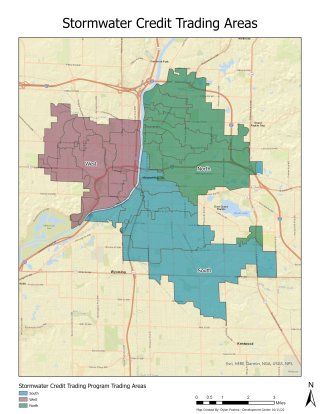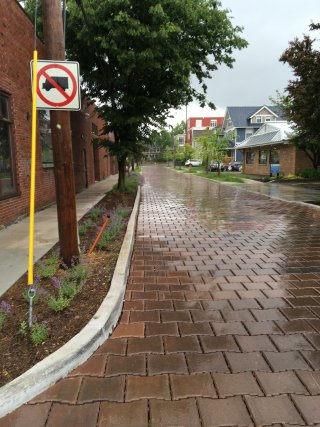City of Grand Rapids Credit Trading Program
Background
The state of Michigan issued the city of Grand Rapids a revised municipal separate storm sewer system (MS4) individual permit in 2021. Part of this permit was a new requirement for most development and redevelopment projects to retain the difference in stormwater runoff between pre-development and post-development conditions for the 2-year, 24-hour storm. The city anticipated that this requirement could be difficult to meet on some project sites due to factors including the region’s poorly draining soils and the high cost of land in critical downtown areas.
At a Glance
Location: Grand Rapids, Michigan
Mechanisms: stormwater credits, in-lieu fee, developer-responsible mitigation
Geographic scope: MS4 service area
Prior to permit issuance, the city worked with the state of Michigan to allow off-site stormwater management in the revised permit. As a result, Grand Rapids developed an off-site stormwater management program with three different mechanisms: a stormwater credit trading program (SCTP), developer-responsible mitigation, and an in-lieu fee. The city of Grand Rapids partnered with American Rivers, a nonprofit organization, to design the SCTP, which launched in 2023.
Program Details
The program goal was to give developers a cost-effective stormwater management solution and to encourage installation of green infrastructure, where appropriate. The flexibility supports the city’s Vital Streets program, which promotes complete and green streets. MS4 permit language, reflected in the city code, specifies avoidance of stormwater infiltration in “hot spots.” Conditions under which the option to use off-site stormwater management would become available may include:
- Limited footprint for infiltration practices even with amended soils
- Soil instability
- Site use inconsistent with capture and reuse of stormwater
- Too much shade or other physical conditions that preclude adequate use of plants
- Potential adverse impacts to water quality associated with stormwater management on the original project site that are greater than the potential water quality benefits for the off-site location
In the STCP, one credit is equal to 1 cubic foot of stormwater retained through green infrastructure. The developer typically submits the application for stormwater credits, though—unless there is a private agreement between them—the property owner owns the credits. The property owner can use those credits to meet current retention requirements, bank them for later use, or put them in the credit trading market. Property owners are responsible for ensuring the credited stormwater control is operated and maintained, as designed, in perpetuity. To encourage stormwater discharge reductions, a property owner using stormwater credits must purchase more stormwater retention capacity than they would need to maintain if meeting their requirements fully on site.

The property owner must also buy the credits from a seller in the same stormwater credit trading zone as the project site. The program divides Grand Rapids into three stormwater credit trading zones, generally based on geographic and watershed boundaries (see map at right). Note that the state of Michigan allows off-site stormwater management arrangements within HUC-10 watersheds (with consideration of other watershed characteristics, such as stream order and location within the watershed), and that all of Grand Rapids is within a HUC-10 watershed. The city set the more stringent three-zone requirement to encourage equal distribution of green infrastructure and economic development.
- How are credits generated? Any property owner can generate credits by installing a stormwater control measure that is either (a) a voluntary green infrastructure practice or (b) a regulated green infrastructure practice that retains more stormwater than required by regulations. Note that the city’s Stormwater Standards manual refers to stormwater control measures as best management practices (BMPs).
- What specific outreach did the city do to make sure potential participants are aware of this off-site option? The city partnered with American Rivers to reach out to multiple MS4 permittees, business groups, watershed groups, and local organizations over several years. The city held workshops, which the state of Michigan also promoted. Outreach has interested business owners in creating small green infrastructure retrofits. This interest drives credit supply. To get started, city-funded projects will provide credits available for use by participants looking to buy.
- How are the required number of stormwater credits calculated? If at least 0.4 inches of stormwater can be managed on site, the property owner must purchase 1.5 times the remaining retention volume in stormwater credits. If less than 0.4 inches of stormwater are managed on site, the property owner must purchase 2 times the remaining retention volume in stormwater credits.

- How do buyers purchase credits? Stormwater credits may be a one-time purchase or require periodic payments of a maintenance fee depending on the purchasing arrangement. The city will provide a purchase contract template and a maintenance agreement template that buyers and sellers may use in negotiations. The purchase contract may include all up-front costs such as construction, permitting, and design and can include a payment plan. The maintenance agreement may include an annual fee that the buyer pays through the life of the stormwater control measure, with the seller held responsible for all stormwater control measure maintenance.
- How does Grand Rapids track credits to ensure compliance? The city added data fields to its existing land use planning and permitting data system. The new fields allow tracking of site maintenance and effective life. (Adding to an existing database cost the city less than creating a new tracking system.) In addition, the city records maintenance agreements as deed restrictions.
Property owners may choose to use developer-responsible mitigation to meet their retention requirements by constructing green infrastructure on a site they control in the same sewershed as the project. The city’s sewersheds are different from the stormwater credit zones (each credit zone encompasses multiple sewersheds).
Payment of an in-lieu fee is only an option if the city has a planned stormwater management project that would meet or exceed the site’s requirements. The size of an in-lieu fee represents the actual cost of the project, so it changes from project to project, but in-lieu fees are likely to be the most expensive option. They serve as the “ceiling” on the market.
Building on Lessons Learned from Other Programs
Before recommending the framework of the SCTP to the city of Grand Rapids, American Rivers studied two SCTP types:

- A one-time credit purchase program that requires buyers and sellers to negotiate a contract. The contract often covers up-front costs of constructing green infrastructure and some margin of profit for the seller. At contract approval, the seller is responsible for maintaining the green infrastructure that generated the credits for the entire contract length. The simplicity of the one-time model results in minimal administrative work for the municipality and no further responsibility for the buyer. However, these agreements can last over 20 years, placing a large maintenance burden on the credit seller.
- An active stormwater credit trading marketplace with annual credit purchases. This short-term design places a greater administrative burden on the municipality and requires sophisticated tools to track credits and associated records. Washington, DC’s Stormwater Retention Credit Program is an example of this type of SCTP.
Grand Rapids’ SCTP is a hybrid of these two types. It has long-term credit contracts and therefore does not introduce a complex marketplace, which reduces administrative burden on the city and reduces the economic impact on developers. This approach will be less expensive over the lifespan of a development project than an active marketplace and will promote developer acceptance. The credit maintenance agreements, meanwhile, allow for annual maintenance fees that relieve some of the seller’s maintenance burden. The SCTP model gives credit purchasers, credit sellers, and the city a way to work together to make stormwater improvements in the community.
